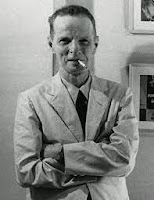The Noir City: Hollywood festival and the UCLA Festival of Preservation are premiering a terrific noir film No abras nunca esa puerta / Never Open that Door (1952), directed by Carlos Hugo Christensen, a key director of Argentina’s golden age of the studio. This policial - as crime films are known in Spanish, from the French policier - was preserved in 2013 by the Film Noir Foundation, on the recommendation of Argentine film historian and archivist Fernando Martín Peña. It has now been completely restored by the FNF through the UCLA Film & Television Archive, with a generous grant from the Golden Globe Foundation
%20Flicker%20Alley%20poster.jpeg) The Film Noir Foundation, founded and headed by film critic and historian Eddie Muller, has been working on making available some of these Argentine films in BluRay and DVD editions, in collaboration with LA-based Flicker Alley. (2)
The Film Noir Foundation, founded and headed by film critic and historian Eddie Muller, has been working on making available some of these Argentine films in BluRay and DVD editions, in collaboration with LA-based Flicker Alley. (2) These policiales have found a new life since their theatrical distribution in the 1950s in Argentina and Latin America. Their relative inaccessibility - except special screenings, occasional TV broadcasts and poor copies on the internet – made them ripe for discovery by modern audiences. They were instances of purloined letters, although their value has been noted in Spanish-language histories of Argentine and Latin American cinema. Los tallos salvajes (1956, directed by Fernando Ayala), La bestia debe morir and El vampiro negro, released in 2021, are now joined by the forthcoming No abras nunca esa puerta, an excellent addition.
What follows are the notes I prepared for a documentary short to be included as one of the bonus materials for its Flicker Alley release. They are relevant to put this policial in a historical and cultural context.
 Director Carlos Hugo Christensen traveled to New York in 1951 to meet Cornell Woolrich and secure the rights to three stories, “Somebody on the Phone”, “Hummingbird Comes Home” and “If I die before I awake”, all of 1937. In an interview with biographer Mario Gallina, the director recalled the meeting: “We met at the Hotel Normandie, where Woolrich was living. I knew beforehand that he had sold the rights to one of his novels, Phantom Lady, to Universal Studios, for $60,000. You can imagine this was a strike against me because what I was going to offer him was way below that sum. Before talking about money, we discussed his literary work. He was pleasantly impressed when he realized that I was very familiar with all of it. At some point, he asked me, ‘How much are you thinking of paying me for these three stories?’. With trepidation, I answered, ‘3,000 dollars each’. He looked at me smiling and said: ‘They are worth four times more. But this time, I’m going to make an exception. The stories are yours’. I think that the enthusiasm he perceived in me for his work, must have influenced his decision. A little time later, when we finished the film, we sent him a copy. He was very happy with the results.” (3)
Director Carlos Hugo Christensen traveled to New York in 1951 to meet Cornell Woolrich and secure the rights to three stories, “Somebody on the Phone”, “Hummingbird Comes Home” and “If I die before I awake”, all of 1937. In an interview with biographer Mario Gallina, the director recalled the meeting: “We met at the Hotel Normandie, where Woolrich was living. I knew beforehand that he had sold the rights to one of his novels, Phantom Lady, to Universal Studios, for $60,000. You can imagine this was a strike against me because what I was going to offer him was way below that sum. Before talking about money, we discussed his literary work. He was pleasantly impressed when he realized that I was very familiar with all of it. At some point, he asked me, ‘How much are you thinking of paying me for these three stories?’. With trepidation, I answered, ‘3,000 dollars each’. He looked at me smiling and said: ‘They are worth four times more. But this time, I’m going to make an exception. The stories are yours’. I think that the enthusiasm he perceived in me for his work, must have influenced his decision. A little time later, when we finished the film, we sent him a copy. He was very happy with the results.” (3)  No abras nunca esa puerta adapted the first two stories, “Somebody on the Phone”, “Hummingbird Comes Home”, and runs for 85 minutes. The third one became a standalone film of 73 minutes. They were released less than a month from one another, If I Die … on April 29 and No abras nunca esa puerta on May 25, in the Ambassador and Ocean theaters on Lavalle Street, the movie house district of downtown Buenos Aires. (4)
No abras nunca esa puerta adapted the first two stories, “Somebody on the Phone”, “Hummingbird Comes Home”, and runs for 85 minutes. The third one became a standalone film of 73 minutes. They were released less than a month from one another, If I Die … on April 29 and No abras nunca esa puerta on May 25, in the Ambassador and Ocean theaters on Lavalle Street, the movie house district of downtown Buenos Aires. (4)El pendiente (1951) – based on the novelette The Death Stone/ The Earring (1943) (as William Irish). Argentina. Dir. León Klimovsky. Written Samuel Eichelbaum, Ulises Petit de Murat. With Mirtha Legrand, José Cibrián, Francisco de Paula.
La huella de unos labios (1952) – story “El cuello de la camisa” / “Collared” (as William Irish). Mexico. Dir. Juan Bustillo Oro. Written Juan Bustillo Oro, Cornell Woolrich. With Rosario Granados, Carlos López Moctezuma, Rubén Rojo.
Si muero antes de despertar / If I Shoud Die Before I Wake (1952) – based on the novelette If I Should Die Before I Wake (1937) (as William Irish). Argentina. Dir. Carlos Hugo Christensen. Written Alejandro Casona, Cornell Woolrich. With Néstor Zavarce, Blanca del Prado, Floren Delbene, Homero Cárpena.
No abras nunca esa puerta (1952) – stories “Somebody on the Phone” and “Hummingbird Comes Home”, both of 1937 (as William Irish). Argentina. Dir. Carlos Hugo Christensen. Written Alejandro Casona, Cornell Woolrich. With Ángel Magaña, Renée Dumas, Nicolás Fregues, Roberto Escalada, Ilde Pirovano.
El ojo de cristal (1956) – based on story “Through a Dead Man’s Eye”. Mexico. Dir. Antonio Santillán. Written Cornell Woolrich, Ignacio F. Iquino, José Antonio de la Loma. With Carlos López Moctezuma, Armando Moreno, Beatriz Aguirre. (7)
 The three Woolrich stories were adapted by Alejandro Casona, the Spanish playwright who lived in Buenos Aires between 1939 and 1962, as a result of the Spanish War. Belonging to the Generation of 1927, together with Luis Buñuel and Federico García Lorca, Casona wrote plays in a style of poetic theater. His collaboration with Christensen is a subject to further explore: the meshing of two very different sensibilities, one poetic, the other melodramatic.
The three Woolrich stories were adapted by Alejandro Casona, the Spanish playwright who lived in Buenos Aires between 1939 and 1962, as a result of the Spanish War. Belonging to the Generation of 1927, together with Luis Buñuel and Federico García Lorca, Casona wrote plays in a style of poetic theater. His collaboration with Christensen is a subject to further explore: the meshing of two very different sensibilities, one poetic, the other melodramatic.The recent restoration of No abras esa puerta opens a door (pun intended) to enjoy a topnotch example during the heyday of Argentine policiales spanning from the mid-1940s to the mid-1950s. The noir vitality – however complicated its classification - can be traced through the following decades. There should be a film series connecting the landmark Hugo Fregonese’s Apenas un delincuente (1949) with modern neo-noirs like Fabián Bielinksy’s Nueve Reinas (2000) and Damián Szifron’s Relatos salvajes (2014) and To Catch a Thriller (2023, a US production). Along the way, the policialesof Adolfo Aristarian – La parte del león (1978), Tiempo de revancha (1981) and Últimos días de la víctima (1982) would substantiate the case. For a larger selection of Argentine crime thrillers in general, De La Fuga a La Fuga (2004) by Roberto Blanco Pazos y Raúl Clemente is a very complete source.
(2) https://flickeralley.com/products/never-open-that-door-no-abras-nunca-esa-puerta

%20poster.jpg)
%20Magan%CC%83a.jpeg)
%20Magan%CC%83a.jpeg)
